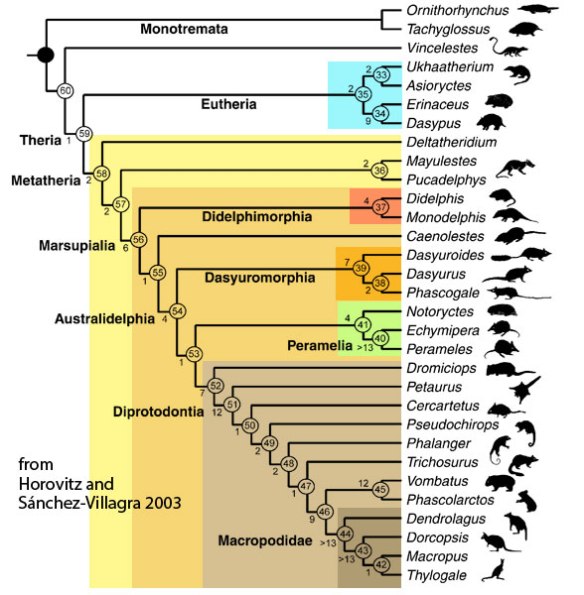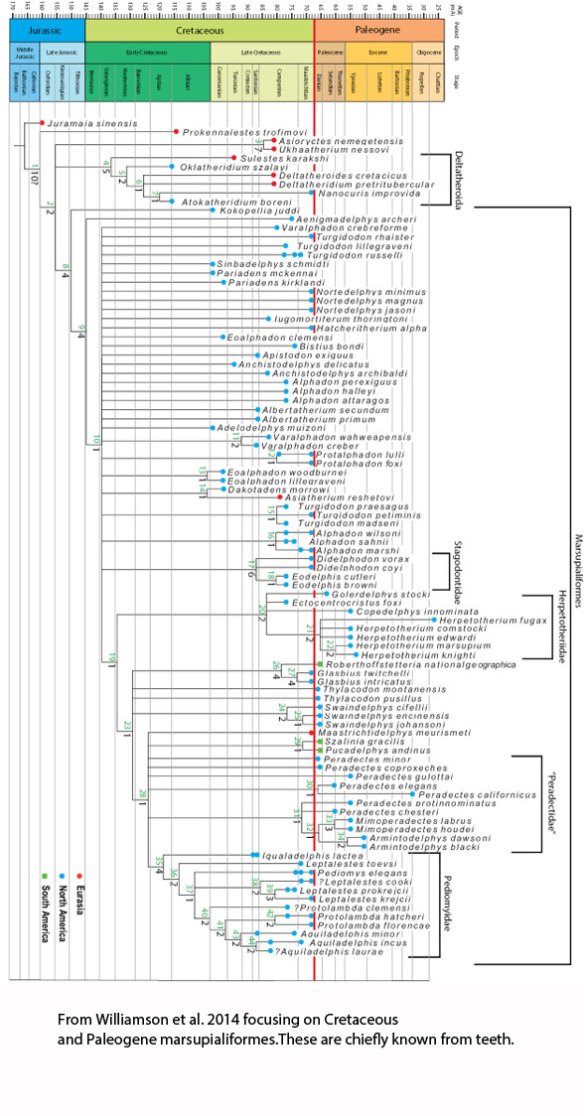If you’re interested in dueling cladograms
today you’ll see how two other cladograms (Figs. 1, 2) compete with the large reptile tree (LRT, subset Fig. 3, 1337 taxa) focusing on Metatheria/Marsupialia.

Figure 1. Marsupial cladogram based on Horovitz and xx 2006. Very few fossil taxa are present here.
Horovitz and Sánchez-Villagra 2003
(Fig. 1) used a trait analysis of mostly extant taxa to create their cladogram. Many prototherian and metatherian fossil taxa are missing here compared to the LRT (Fig. 3) where wombats and kangaroos have separate origins (Dasyurus is a last common ancestor), contra Horovitz and Sánchez-Villagra. And where is Sarcophilus (the Tasmanian devil)?

Figure 2. Marsupialiformes by Williamson et al. 2014 focusing on Cretaceous and Paleogene forms. Most of these are teeth and jaws only. By contrast the LRT includes many extant and recently extinct taxa known from skeletons.
Williamson et al. 2014
(Fig. 2) also lack a large number of fossil taxa and appear to avoid extant taxa compared to the LRT (Fig. 3). And where is Ernanodon (the Palaeocene Tasmanian devil)?

Figure 3. Subset of the LRT focusing on basal Mammalia. Both fossil and extant taxa are included here.
Reconstructions
(Fig. 4) help confirm that a list of sister taxa in a cladogram really do look like they are related to one another and demonstrate a gradual accumulation of traits (in lieu of laboriously examining all the data scores and confirming their validity with a worldwide trip to visit all the fossils firsthand).

Figure 4. From yesterday’s post, a selection of Therian skulls leading to placentals. This is the ‘gradual accumulation of traits’ recovered by the LRT.
A few words of wisdom from Neil deGrasse Tyson
“Cognitive bias is all the ways we fool ourselves. Science. The only point of the scientific method is to make sure you are not fooled into thinking that something is true that is not, or thinking that something is not true that is… that is the only point.”
To that end:
Adding taxa to the LRT tests and strains the data within that creates the cladograms presented here (Fig. 3). Errors are exposed and corrections are made. Today, the LRT cladogram remains highly resolved. That pretty much invalidates past criticisms. Today’s criticisms of those who think they are following the scientific method (Figs. 1, 2) are meant to get these authors to add relevant taxa, consider other candidates and options, re-examine their recovered trees, so that when they think something is true it will pass all tests and achieve confirmation and consensus that it is true… until the next study comes along to challenge it.
References
Horovitz I and Sánchez-Villagra MR 2003. A morphological analysis of marsupial mammal higher-level phylogenetic relationships. Cladistics 19: 181–112. doi: 10.1111/j.1096-0031.2003.tb00363.x PDF
Williamson TE and Brusatte SL and Wilson GP 2014. The origin and early evolution of metatherian mammals: the Cretaceous record. Zookeys. 2014; (465): 1–76.
Published online 2014 Dec 17. doi: [10.3897/zookeys.465.8178]
PMCID: PMC4284630 PMID: 25589872
